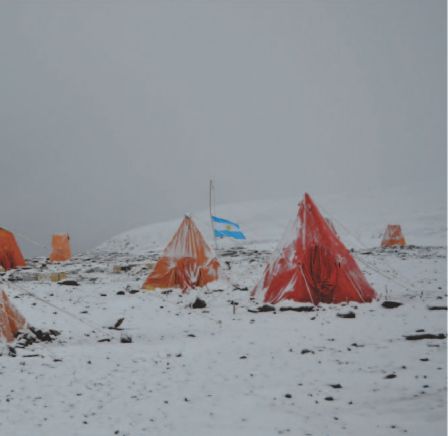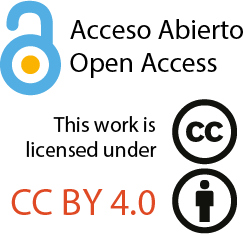THE ANTARCTIC FOSSIL VERTEBRATE COLLECTION OF THE MUSEO DE LA PLATA: HISTORICAL PERSPECTIVE OF FOUR DECADES OF EARTH SCIENCES INVESTIGATIONS IN ANTARCTICA
La colección Antártica de vertebrados fósiles del Museo de La Plata: Perspectiva histórica de cuatro décadas de investigaciones de ciencia de la Tierra en Antártida.
DOI:
https://doi.org/10.5710/PEAPA.05.09.2024.465Keywords:
Antarctic repositories, vertebrate paleontology, campaigns, researchers, logisticsAbstract
The Museo de La Plata (MLP, Facultad de Ciencias Naturales y Museo, Universidad Nacional de La Plata) houses Antarctica’s largest fossil vertebrate collection. This collection is a major international research resource and constitutes one of Antarctica’s most important records of vertebrate history and evolution. The principal focus of this collection is on vertebrate fossils from the Antarctic Peninsula (Late Cretaceous and Paleogene of the James Ross Archipelago, NE Antarctic Peninsula and the Jurassic of the Antarctic Peninsula). The collection is estimated to consist of over 32,000 specimens, including fossils of fishes, anurans, marine reptiles (plesiosaurs and mosasaurs), avian and non-avian dinosaurs, turtles, and marine and terrestrial mammals. The collection comprises many complete and extraordinarily well-preserved skeletons and has 22 holotypes. It also contains several institutional icons, including the skeletons of the elasmosaurid plesiosaur Vegasaurus and several non-avian dinosaurs such as Antarctopelta and Trinisaura, as well as non-avian dinosaurs Vegavis and Conflicto. The MLP Antarctic fossil vertebrate collection dates from 1978; its importance lies not only in the fact that it is globally one of the main reference collections of Antarctic paleontological material but also in its high proportion of Mesozoic and Cenozoic faunas, which can be used to understand evolutionary dynamics, continental movements, and climatic changes over the past 80 Ma. The collection was made under the auspices and agreement between the Dirección Nacional del Antártico - Instituto Antártico Argentino and the Museo de La Plata in 1983.
References
Acosta Hospitaleche, C. (2013). New crania from Seymour Island (Antarctica) that shed light on anatomy of Eocene penguins. Polish Polar Research, 34, 397–412.
Acosta Hospitaleche, C. (2014). New penguin giant bones from Antarctica: systematic and paleobiological significance. Comptes Rendus Palevol, 13, 555–560.
Acosta Hospitaleche, C. (2016). Paleobiological remarks on a new partial skeleton of the Eocene Antarctic penguin Palaeeudyptes klekowskii. Ameghiniana, 53, 269–281.
Acosta Hospitaleche, C. & Di Carlo, U. (2010). The coracoids in functional and morphological studies of penguins (Aves, Spheniscidae) of the Eocene of Antarctica. Rivista Italiana di Paleontologia e Stratigrafia, 116, 23–34.
Acosta Hospitaleche, C. & Di Carlo, U. (2012). Una singular escápula de pingüino (Aves; Sphenisciformes) del Eoceno de Antártida: reconstrucción muscular e implicancias funcionales. Rivista Italiana di Paleontologia e Stratigrafia, 118(3), 493–501.
Acosta Hospitaleche, C. & Gelfo, J. (2015). New Antarctic finding of Upper Cretaceous and early Eocene Gaviiformes. Annales de Paleontologie, 101, 315–324.
Acosta Hospitaleche, C. & Gelfo, J. (2017). Procellariiform remains and a new species from the latest Eocene of Antarctica. Historical Biology, 29(6), 1–15.
Acosta Hospitaleche, C. & Jadwiszczak, P. (2011). Enigmatic morphological disparity in tarsometatarsi of giant penguins from the Eocene of Antarctica. Polish Polar Research, 32(3), 175–180.
Acosta Hospitaleche, C. & Jones, W. (2024). Were terror birds the apex continental predators of Antarctica? New findings in the early Eocene of Seymour Island. Paleontología Electrónica, 27(1):a13. https://doi.org/10.26879/1340
Acosta Hospitaleche, C. & Reguero, M. (2010). First articulated skeleton of Palaeeudyptes gunnari from the late Eocene of Seymour (= Marambio) Island (Antarctica). Antarctic Sciences, 22, 289–298.
Acosta Hospitaleche, C. & Reguero, M. (2011). Taxonomic notes about Ichtyopteryx gracilis Wiman, 1905 and Orthopteryx gigas Wiman, 1905 (Aves, Spheniscidae). Alcheringa, 35, 463–466.
Acosta Hospitaleche, C. & Reguero, M. (2020). Additional Pelagornithidae remains from Seymour Island, Antarctica. Journal of South American Earth Sciences, 99, 102504. https://doi.org/10.1016/j.jsames.2020.102504
Acosta Hospitaleche, C. & Worthy, T. (2021). New data on the Vegavis iaai holotype from the Maastrichtian of Antarctica. Cretaceous Research. 124, 104818. https://doi.org/10.1016/j.cretres.2021.104818
Acosta Hospitaleche, C., Reguero, M., & Scarano, A. (2013). Main pathways in the evolution of the Paleogene Antarctic Sphenisciformes. Journal of South American Earth Sciences, 43, 101–111.
Acosta Hospitaleche, C., Perez, L., Acosta, W. & Reguero, M. (2012). A traumatic fracture in a giant Eocene penguin from Antarctica. Antarctic Sciences, 24(6), 619–624.
Acosta Hospitaleche, C., Pérez, L., Marenssi, S., & Reguero, M. (2016). Taphonomic analysis of Crossvallia unienwillia Tambussi et al. 2005: significance of the oldest penguin record of Antarctica. Ameghiniana, 53, 282–295.
Acosta Hospitaleche, C. Hagstrom, J., Mörs, T., & Reguero, M. (2017). Historical perspective of Otto Nordenskjöld´s Antarctic fossil penguin collection and Carl Wiman’s contribution. Polar Record, 53, 364–375.
Acosta Hospitaleche, C., Haidr, N., Paulina Carabajal, A., & Reguero, M. (2019a). First skull of Anthropornis grandis associated with postcranial elements. Comptes Rendus Paleovol, 18, 599–617.
Acosta Hospitaleche, C., Jadwiszczak, P., Clarke, J., & Cenizo, M. (2019b). The fossil record of birds from the James Ross Basin, West Antarctica. Advances in Polar Sciences, 30(3), 251–273.
Acosta Hospitaleche, C., de los Reyes, M., Santillana, S., & Reguero, M. (2020). First Neornithes fossil skin of a giant penguin from Antarctica. Lethaia. 53(3), 409–420.
Acosta Hospitaleche, C., Gelfo, J., Quaggia, B., & Reguero, M. (2022). Taphonomy of two Holocene penguin taphocoenoses in Potter Peninsula, South Shetland Islands, Antarctica Historical Biology, 35(11), 1–18.
Acosta Hospitaleche, C., Irazoqui, F., Bona, P., & Paulina-Carabajal, A. (2024). Review of the Cretaceous avian diversity of Antarctica: a changing scenario for the evolution of early Neornithine birds. Advances in Polar Science, 35(1), 1– 13.
Ameghino, F. (1905). Enumeración de los Impennes fósiles de Patagonia y de la isla Seymour. Anales del Museo Nacional de Buenos Aires, 6, 97–167.
Bona, P., de la Fuente, M. S., & Reguero, M. A. (2010). New fossil turtle remains from the Eocene of the Antarctic Peninsula. Antarctic Sciences, 22(5), 531–532.
Bona, P., Pereyra, M. E., Gelfo, J., Acosta Hospitaleche, C., Garcia López, D. A., Irazoqui, F., & Reguero, M. A. (2022). A recent discovery sheds light on the presence of crocodiles in the Eocene of West Antarctica. Publicación Electrónica de la Asociación Paleontológica Argentina, 24(R), R35.
Bond, M., Reguero, M. A., Vizcaíno, S. F.,& Marenssi, S. A. (2006). A new “South American ungulate” (Mammalia: Litopterna) from the Eocene of Antarctic Peninsula. Special Publication of the Geological Society of London, 258, 163–176.
Bond, M., Kramarz, A., Macphee, R., & Reguero, M. (2011). A new astrapothere (Mammalia, Meridiungulata) from La Meseta Formation, Seymour (Marambio) Island, and a reassessment of previous records of Antarctic astrapotheres. American Museum Novitates, 3718, 1–16.
Buono, M. R., Fernández, M. S., Reguero, M. A., Marenssi, S. A., Santillana, S. N., & Mörs, T. (2016). Eocene basilosaurid whales from the La Meseta Formation, Marambio (Seymour) Island, Antarctica. Ameghiniana, 53(3), 296–315.
Cenizo, M., Noriega, J., & Reguero, M. (2016). A stem falconid bird from the Lower Eocene of Antarctica and the early southern radiation of the falcons. Journal of Ornithology, 157, 885–894. https://doi.org/10.1007/s10336-015-1316-0
Charnelli, M., Gouiric-Cavalli, S., Reguero, M. A., & Cione, A. L. (2024). Middle Eocene chondrichthyan fauna from Antarctic Peninsula housed in the Museo de la Plata, Argentina. Special Volume Advances in Polar Science, 35(1), 14–47.
Cione, A. L., Del Valle, R. A., Rinaldi, C. A., & Tonni, E. P. (1977). Nota preliminar sobre los pingüinos y tiburones del Terciario inferior de la isla Vicecomodoro Marambio, Antártida. Contribuciones del Instituto Antártico Argentino, 213, 1–21.
Cione, A. L., Reguero, M., & Acosta Hospitaleche, C. (2007). Did the continent and sea have different temperatures in the northern Antarctic Peninsula during the Middle Eocene? Revista de la Asociación Geológica Argentina, 62(4), 586–596.
Cione A. L., Santillana.S., Gouiric-Cavalli. S., Acosta Hospitaleche, C., Gelfo, J., López, G., & Reguero, M. (2018). Before and after the K/Pg extinction in West Antarctica: New marine fish records from Marambio (Seymour) Island. Cretaceous. Research, 85, 250–265. https://doi.org/10.1016/j.cretres.2018.01.004
Clarke, J. A., Tambussi, C. P., Noriega, J. I., Erickson, G. M., & Ketcham, R. A. (2005). Definitive fossil evidence for the extant avian radiation in the Cretaceous. Nature, 433, 305–308.
Coria, R. A., Moly, J. J., Reguero, M. A., Santillana, S. N., & Marenssi, S. A. (2013). A new ornithopod (Dinosauria; Ornithischia) from Antarctica. Cretaceous Research, 42, 186–193.
Del Valle, R. A., Elliot, D. H., & Macdonald, D. I. (1992). Sedimentary basins on the east flank of the Antarctic Peninsula: proposed nomenclature. Antarctic Science, 4, 477–478.
Eights, J. (1833). Description of a new crustaceous animal found on the shores of the South Shetland Islands, with remarks on their natural history. Transactions of the Albany Institute, 2(1), 53–69.
Elliot, D. H. (1988). Preface. In: R. M. Feldmann & M. O. Woodburne (Eds.) Geology and paleontology of Seymour Island, Antarctic Peninsula. Geological Society of America Memoir, 169, ix-x.
Goin, F. J., Case, J. A., Woodburne, M. O., Vizcaíno, S. F., & Reguero, M. A. (1999). New discoveries of “opossum-like” marsupials from Antarctica (Seymour Island, Medial Eocene). Journal of Mammalian Evolution, 6(4), 335–365.
Goin, F. J., Reguero, M. A., Pascual, R., Von Koenigswald, W., Woodburne, M. O., Case, J. A., Marenssi, S. A., Vieytes, C., &Vizcaíno, S. F. (2006).First gondwanatherian mammal from Antarctica. Geological Society of London Special Publications, 258, 135–144.
Haidr, N. & Acosta Hospitaleche, C. (2017a). Fossil penguin beaks from the Eocene of Antarctica: new materials from La Meseta Formation. Volumen Especial Revista del Museo Argentino de Ciencias Naturales, 7, 57–68.
Haidr, N. & Acosta Hospitaleche, C. (2017b). A new penguin cranium from Antarctica and its implications for body size diversity during the Eocene. Neues Jahrbuch für Geologie und Paläontologie, 286(2), 229–233.
Hughes, K. A., Carcavilla, L., Crame, A., Díaz-Martínez, E., Elliot, D., Francis, J., López-Martínez, J., & Reguero, M. (2020). Seymour (Marambio) Island: an outstanding example of Antarctic geological heritage. Antarctic Science, 32(3), 167. https://doi.org/10.1017/S0954102020000267
Jadwiszczak, P. & Acosta Hospitaleche, C. 2013. Distinguishing between two Antarctic species of Eocene Palaeeudyptes penguins: A statistical approach using tarsometatarsi. Polish Polar Research, 34(3), 237–252.
Jadwiszczak, P., Acosta Hospitaleche, C., & Reguero, M. A. (2013). Redescription of Crossvallia unienwillia: The only Paleocene Antarctic Penguin. Ameghiniana, 50(6), 545–553.
Larsen, C. A. (1894). The voyage of the Jason to the Antarctic regions. Geographical Journal of London, 19(4), 333–344.
Marples, B. J. (1953). Fossil penguins from the mid-Tertiary of Seymour Island. London, HMSO. Falkland Islands Dependencies Survey Scientific Reports, 5, 1–15.
Martinelli, A. G., Chornogubsky, L., Abello, M. A., Goin, F. J., & Reguero, M. A. (2014). The first non-therian dryolestoid from Antarctica. Abstracts of the SCAR Open Science Conference. Auckland.
Montalti, D., Acosta Hospitaleche, C., Del Valle, R. D. (2009). New Holocene penguin assemblages at South Shetland Islands, Antarctica. Neues Jahrbuch für Geologie und Paläontologie, 11(3), 349–357.
Montes, M., Nozal, F., Santillana, S. N., Marenssi, S. A., & Olivero, E. B. (2013). Mapa Geológico de la isla Marambio/Seymour escala 1:20.000 primera edición. Serie Cartográfica Geocientífica Antártica. Madrid: Instituto Geológico y Minero de España, Buenos Aires: Instituto Antártico Argentino.
Mörs, T., Reguero, M., & Vasilyan, D. (2020). First fossil frog from Antarctica: implications for Eocene high latitude climate conditions and Gondwanan cosmopolitanism of Australobatrachia. Scientific Report, 10, 5051. https://doi.org/10.1038/s41598-020-61973-5
O’Gorman, J. P., Salgado, L., Olivero, E. B., & Marenssi, S. A. (2015). Vegasaurus molyi, gen. et sp. nov. (Plesiosauria, Elasmosauridae), from the Cape Lamb Member (lower Maastrichtian) of the Snow Hill Island Formation, Vega Island, Antarctica, and remarks on Weddellian Elasmosauridae. Journal of Vertebrate Paleontology, 35, e931285. http://dx.doi.org/10.1080/02724634.2014.931285
O’Gorman, J. P., Aspromonte, F., & Reguero, M. (2021). New data on one of the first plesiosaur (Reptilia, Sauropterygia) skeletons recovered from Antarctica, with comments on the dorsal sacral and regions of elasmosaurids. Alcheringa, 45(3), 1–15.
O’Gorman, J. P., Canale, J. L., Bona, P., Tineo, D. E., Reguero, M., & Cárdenas, M. (2024). A new elasmosaurid (Plesiosauria; Sauropterygia) from López de Bertodano Formation: new data on the evolution of the aristonectine morphology. Journal of Systematic Palaeontology, htpps://doi.org/10.1080/14772019.2024.2312302
Reguero, M. A. (2019). Antarctic Paleontological Heritage: Late Cretaceous–Paleogene vertebrates from Seymour (Marambio) Island, Antarctic Peninsula. Advances in Polar Science, 30(3), 328–355.
Reguero, M. A. & Gasparini, Z. (2023). El Museo de La Plata y la Antártida: 50 años de expediciones paleontológicas de vertebrados. Museo, 35, 4–73.
Reguero, M. A., Tambussi, C. P., Coria, R. A., & Marenssi, S. A. (2013a). Late Cretaceous dinosaurs from the James Ross Basin, West Antarctica. Geological Society of London Special Publications, 381, 99–116. https://doi.org/10.1144/SP381.20
Reguero, M. A., Goin, F. J., Acosta Hospitaleche, C.; Dutra, T., & Marenssi, S. A. (2013b). Late Cretaceous/Paleogene West Antarctica terrestrial biota and its intercontinental affinities. Springer.
Reguero, M. A. & Goin, F. J. (2021). Paleogeography and biogeography of the Gondwanan final breakup and its terrestrial vertebrates: New insights from southern South America and the “double Noah’s Ark” Antarctic Peninsula. Journal of South American Earth Sciences, 108, 103358. https://doi.org/10.1016/j.jsames.2021.103358
Reguero, M. A., Gasparini, Z., Coria, R. A., Fernández, M. S., O'Gorman, J. P., Gouiric-Cavalli, S., Acosta Hospitaleche, C., Bona, P., Iglesias, A., Gelfo, J. N., Raffi, M. E., Moly, J. J., Santillana, S., & Cárdenas, M. (2022). Late Campanian-Early Maastrichtian Vertebrates from The James Ross Basin, West Antarctica: Updated Synthesis, Biostratigraphy, and Paleobiogeography. Annals of the Brazilian Academy of Sciences, 94(1), 4–35.
Salgado, L. & Gasparini, Z. (2006). Reappraisal of an ankylosaurian dinosaur from the Upper Cretaceous of James Ross Island (Antarctica). Geodiversitas, 28, 119–135.
Sharman, G. & Newton, E. T. (1894). Note on some fossils from Seymour Island, in the Antarctic regions, obtained by Dr. Donald. Transactions of the Royal Society of Edinburgh, 37, 707–709.
Tambussi, C. P. & Acosta Hospitaleche, C. (2007). Aves antárticas (Neornithes) durante el lapso Cretácico–Eoceno. Revista de la Asociacion Geologica Argentina, 62(4), 604–617.
Tambussi, C. P., Reguero, M. A., Marenssi S. A., & Santillana, S. N. (2005). Crossvallia unienwillia, a new Spheniscidae (Sphenisciformes, Aves) from the Late Paleocene of Antarctica. Geobios, 38, 667–675.
Tambussi, C., Acosta Hospitaleche, C., Reguero, M., & Marenssi, S. (2006). Late Eocene penguins from West Antarctica: systematics and biostratigraphy. Geological Society of London Special Publications, 258, 145–161.
Tambussi, C. P., Degrange, F. J., de Mendoza, R. S., Sferco, E., & Santillana, S. (2019). A stem anseriform from the early Palaeocene of Antarctica provides new key evidence in the early evolution of waterfowl. Zoological Journal of the Linnean Society, 186, 673–700.
Tonni, E. P. & Cione, A. L. (1978). Una nueva colección de Vertebrados del Terciario inferior de la isla Vicecomodoro Marambio (Seymour Island), Antártida. Obra del Centenario del Museo de La Plata, 5, 73–79.
Wiman, C. (1905a). Über die alttertiären Vertebraten der Seymourinsel. Wissenschaftliche Ergebnisse der Schwedischen Südpolar Expedition 1901–1903, 3, 1–37.
Wiman, C. (1905b). Vorläufige Mitteilungüber die alttertiärenVertebraten der Seymourinsel. Bulletin of the Geological Institute of Uppsala, 6, 247–253.

Downloads
Published
Issue
Section
License
Copyright (c) 2025 Marcelo Reguero, Carolina Acosta Hospitaleche, Jose Patricio O'Gorman, Juan José Moly

This work is licensed under a Creative Commons Attribution-NoDerivatives 4.0 International License.
Authors retain copyright and grant the journal right of first publication with the work simultaneously licensed under a Atribución/Reconocimiento 4.0 Internacional that allows others to share the work with an acknowledgement of the work's authorship and initial publication in this journal.















